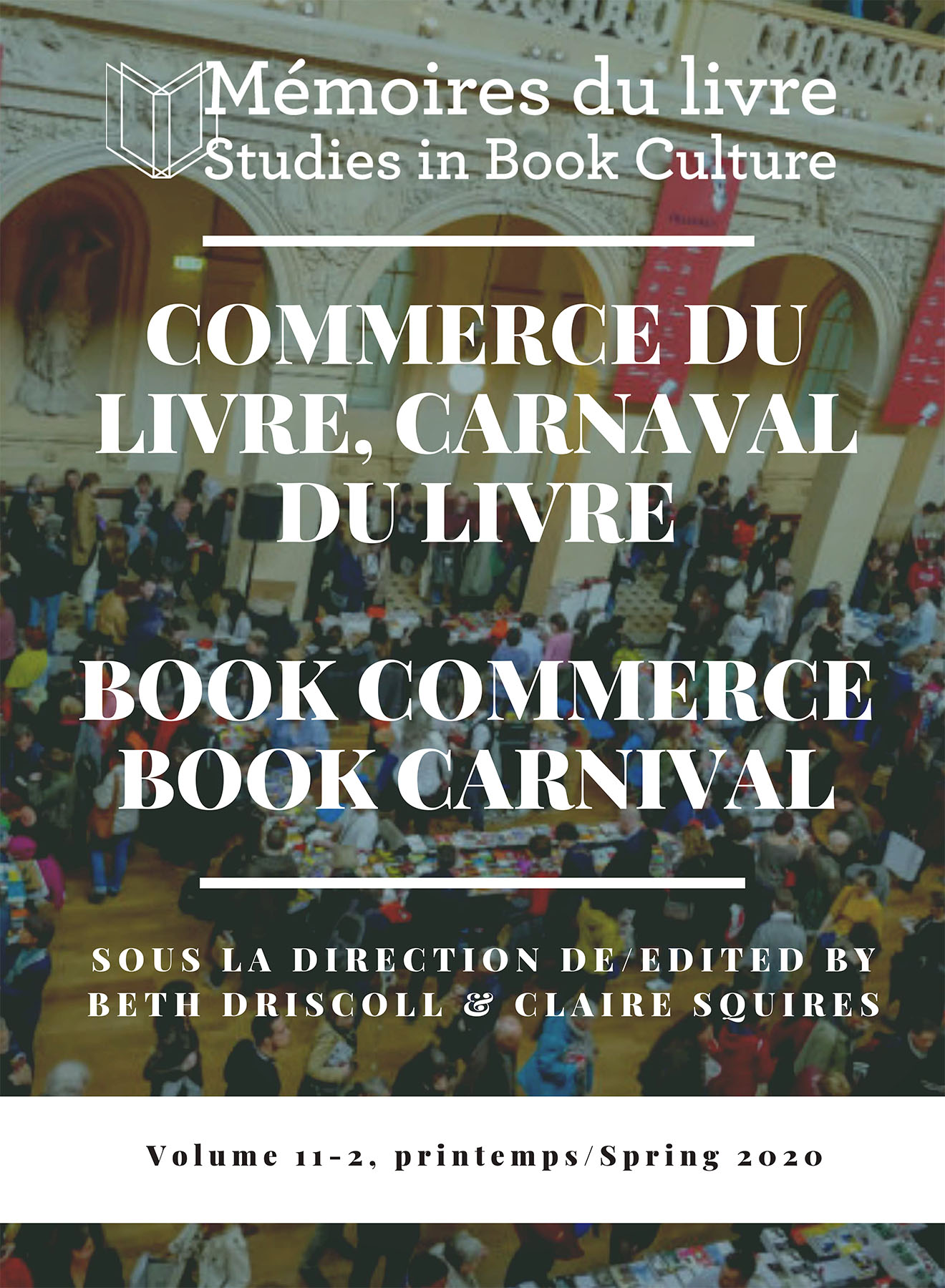Résumés
Abstract
The canvas tote bag, often branded with the name and logo of a popular cultural institution or bookstore, has become a shorthand for an individual’s accumulated cultural capital; this seemingly innocuous accessory has the power to signal to one’s peers the level of their engagement with the cultural and creative industries in a seemingly casual but deeply coded manner. The literary festival presents the perfect opportunity for individuals to signal to those around them that they, for example, subscribe to the New Yorker or donate money to the V&A museum. This article presents the findings of an observational study conducted at four literary festivals in Australia, the United Kingdom and the United States. Four distinct categories emerged from this analysis of tote bags carried at literary festivals: the festival tote that is sold at the festival; totes associated with cultural institutions; totes with political, satirical or ironic slogans; totes that are not associated with any particular arts or cultural brand or institution. I argue that, especially where the first three categories are concerned, the tote bags carried at literary festivals are consciously chosen for the purpose of signalling one’s cultural capital.
Keywords:
- Tote bags,
- cultural capital,
- literary festivals,
- conspicuous consumption,
- Bourdieu
Résumé
Le sac fourre-tout en toile, souvent marqué du nom et du logo d’une institution culturelle ou librairie populaires, est devenu un raccourci pour signifier le capital culturel accumulé par une personne. Par cet accessoire en apparence inoffensif, elle peut attirer l’attention de ses pairs sur le degré auquel elle souscrit aux industries culturelles et créatives, d’une manière qui se veut décontractée mais est en réalité profondément codée. Le festival littéraire constitue l’occasion idéale pour signaler aux autres qu’elle est une abonnée du New Yorker ou une donatrice du musée Victoria and Albert, par exemple. L’article présente les résultats d’une étude observationnelle menée dans quatre festivals littéraires en Australie, au Royaume-Uni et aux États-Unis. Quatre catégories distinctes se dégagent de cette analyse des sacs fourre-tout utilisés lors de ces festivals : le sac à l’effigie du festival vendu sur place; le sac associé à une institution culturelle; le sac portant un slogan politique, satirique ou ironique; et enfin, le sac qui n’est associé à aucune marque ou institution artistique ou culturelle particulières. Je soutiens que, particulièrement en ce qui concerne les trois premières catégories, le sac arboré lors de festivals littéraires est choisi de façon consciente, dans le but de rendre manifeste le capital culturel de celui ou celle qui le porte.
Mots-clés :
- Sacs fourre-tout,
- capital culturel,
- festivals littéraires,
- consommation ostentatoire,
- Bourdieu
Parties annexes
Bibliography
- Albrecht, Leslie. “How a Free Canvas Tote Became a Bigger Status Symbol than a $10,000 Hermes Bag.” Market Watch, September 9, 2017. https://www.marketwatch.com/story/how-a-free-canvas-tote-became-a-bigger-status-symbol-than-a-10000-hermes-bag-2017-09-01.
- Benson, Louise. “Totes Awesome? The Rise and Rise of the Art and Design Tote Bag.” Elephant, June 12, 2019. https://elephant.art/totes-awesome-rise-rise-art-design-tote-bag/.
- Berger, John, and Morgan Ward. “Subtle Signs of Inconspicuous Consumption” Journal of Consumer Research 37 (2010): 555–69.
- Bourdieu, Pierre. Distinction: A Social Critique of the Judgement of Taste. Oxford: Routledge, 1984.
- Clements, Mikaella. “Unpacking Berlin’s Mysterious Ubiquitous Tote Bag.” New York Times, September 3, 2019. https://www.nytimes.com/2019/09/03/style/berlin-tote-hugendubel.html.
- Driscoll, Beth. The New Literary Middlebrow: Tastemakers and Reading in the Twenty-First Century. New York, London: Palgrave MacMillan, 2014.
- Edwards, Chris. “Life Cycle Assessment of Supermarket Carrier Bags: A Review of the Bags Available in 2006.” A report for the Environment Agency, UK, 2006. https://assets.publishing.service.gov.uk/government/uploads/system/uploads/attachment_data/file/291023/scho0711buan-e-e.pdf.
- Everything You Need to Know About the 2017 Hay Festival. BBC, 2017. https://www.bbc.co.uk/programmes/articles/25fDmhSDpmNxyWqnTPggJ8s/everything-you-need-to-know-about-the-2017-hay-festival.
- Gaynor, Jessie. “‘Why Can’t I Buy a Joan Didion Tote?’ And More Questions from the Expanded Lit Hub Universe Answered.” Literary Hub, December 18, 2019. https://lithub.com/why-cant-i-buy-a-joan-didion-tote-and-more-questions-from-the-expanded-lit-hub-universe-answered/.
- Gayomali, Chris. “The Best Media Tote Bags, Ranked.” GQ, May 31, 2019. https://www.gq.com/story/best-media-totes.
- Gould, Emily (@EmilyGould). “If I’ve learned anything….” Twitter, January 9, 2019. https://twitter.com/EmilyGould/status/1082661011742752768.
- Harlem Book Fair. 2019. https://www.harlembookfair.com/about-us.
- Hay Festival Friends. 2019. https://www.hayfestival.com/wales/friends.
- Hay Festival Sponsorship. 2019. https://www.hayfestival.com/wales/sponsorship.
- Holt, Douglas B. “Does Cultural Capital Structure American Consumption?” Journal of Consumer Research 25, no. 1 (1998): 1–25.
- Jorgensen, Danny L. The Methodology of Participant Observation. Thousand Oaks, CA: Sage Publications, 2011.
- Lury, Celia. “Brand as Assemblage: Assembling Culture.” Journal of Cultural Economy 2, no. 1–2 (2009): 67–82.
- Ministry of Environment and Food of Denmark. “Life Cycle Assessment of Grocery Carrier Bags.” A Report for the Danish Environmental Protection Agency, 2018. https://www2.mst.dk/Udgiv/publications/2018/02/978-87-93614-73-4.pdf.
- Musante (DeWalt), Kathleen, and Billie R. DeWalt. Participant Observation: A Guide for Fieldworkers. Lanham, MD: Altamira Press, 2010.
- Ommundsen, Wenche. “Literary Festivals and Cultural Consumption.” Australian Literary Studies 24, no. 1 (2009): 19–34.
- Printers Row Lit Fest, 2019. https://printersrowlitfest.org/.
- “Printers Row Lit Fest Brings Out More Than 100,000 People In First Day.” CBS Chicago, June 8, 2019. https://chicago.cbslocal.com/2019/06/08/printers-row-lit-fest-brings-out-more-than-100000-people-in-first-day/.
- Robinson, Mike, and Marina Novelli. “Niche Tourism: An Introduction,” in Niche Tourism, ed. Marina Novelli, 1–10. Oxford: Butterworth-Heinemann, 2005.
- Rosen, Ellis. “Tote Bag Culture Etiquette.” New Yorker, January 7, 2018. https://www.newyorker.com/humor/daily-shouts/tote-bag-culture-etiquette.
- Strong, Catherine, and Samuel Whiting. “‘We Love the Bands and We Want to Keep the on the Walls’: Gig Posters as Heritage-as-Praxis in Music Venues.” Continuum 32, no. 2 (2017): 151–61.
- Technavio. “Global Tote Bags Market 2019–2023.” 2019. https://www.technavio.com/report/global-tote-bags-market-industry-analysis?tnplus.
- Veblen, Thorsten. The Theory of the Leisure Class: An Economic Study of Institutions, edited with an introduction by Martha Banta. Oxford: Oxford University Press, 2007.
- Weber, Millicent. “At the Intersection of Writers Festivals and Literary Communities.” Overland, September 6, 2017. https://overland.org.au/2017/09/at-the-intersection-of-writers-festival-and-literary-communities/.
- Weber, Millicent. Literary Festivals and Contemporary Book Culture. New York, London: Palgrave MacMillan, 2018.


